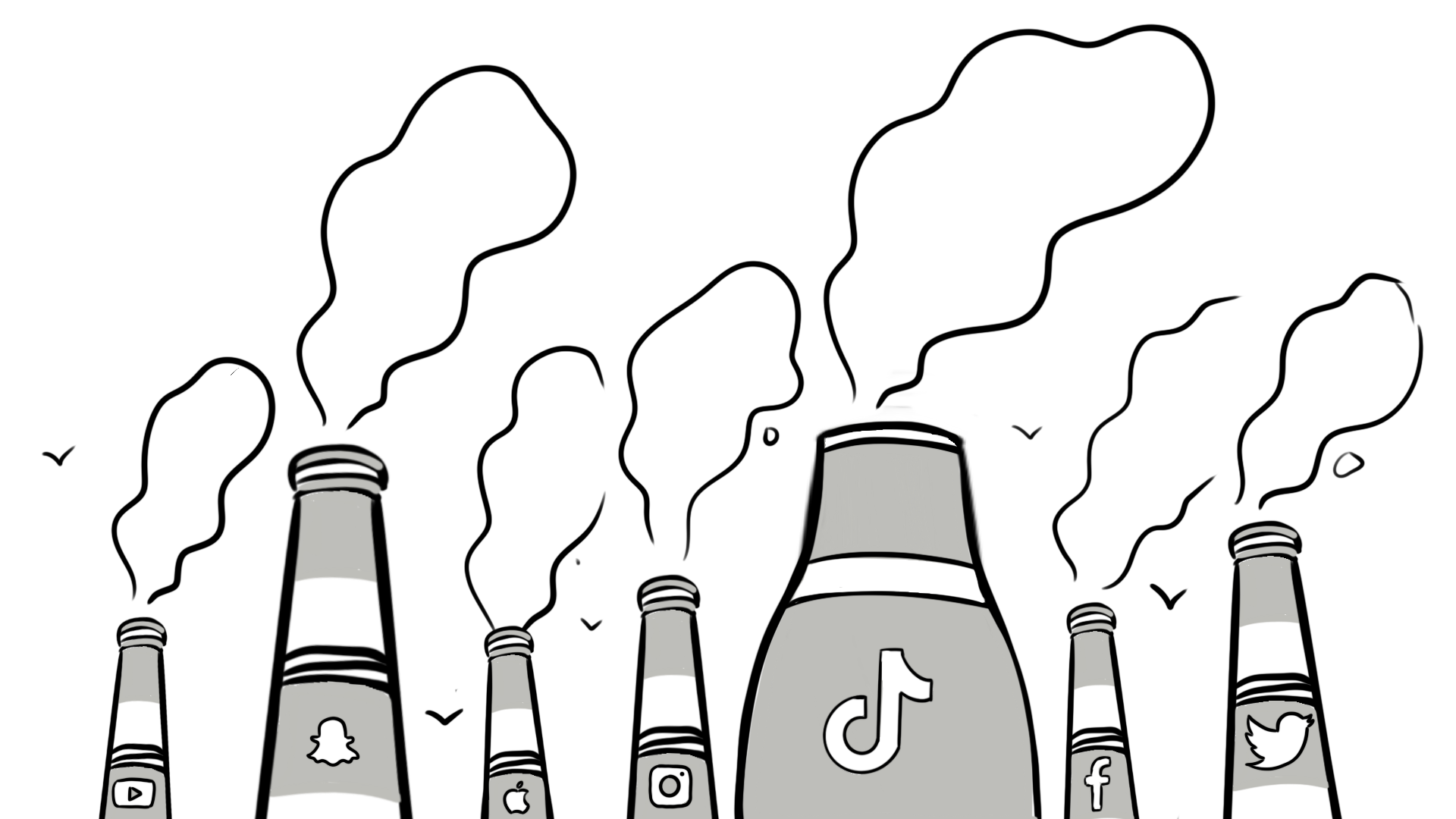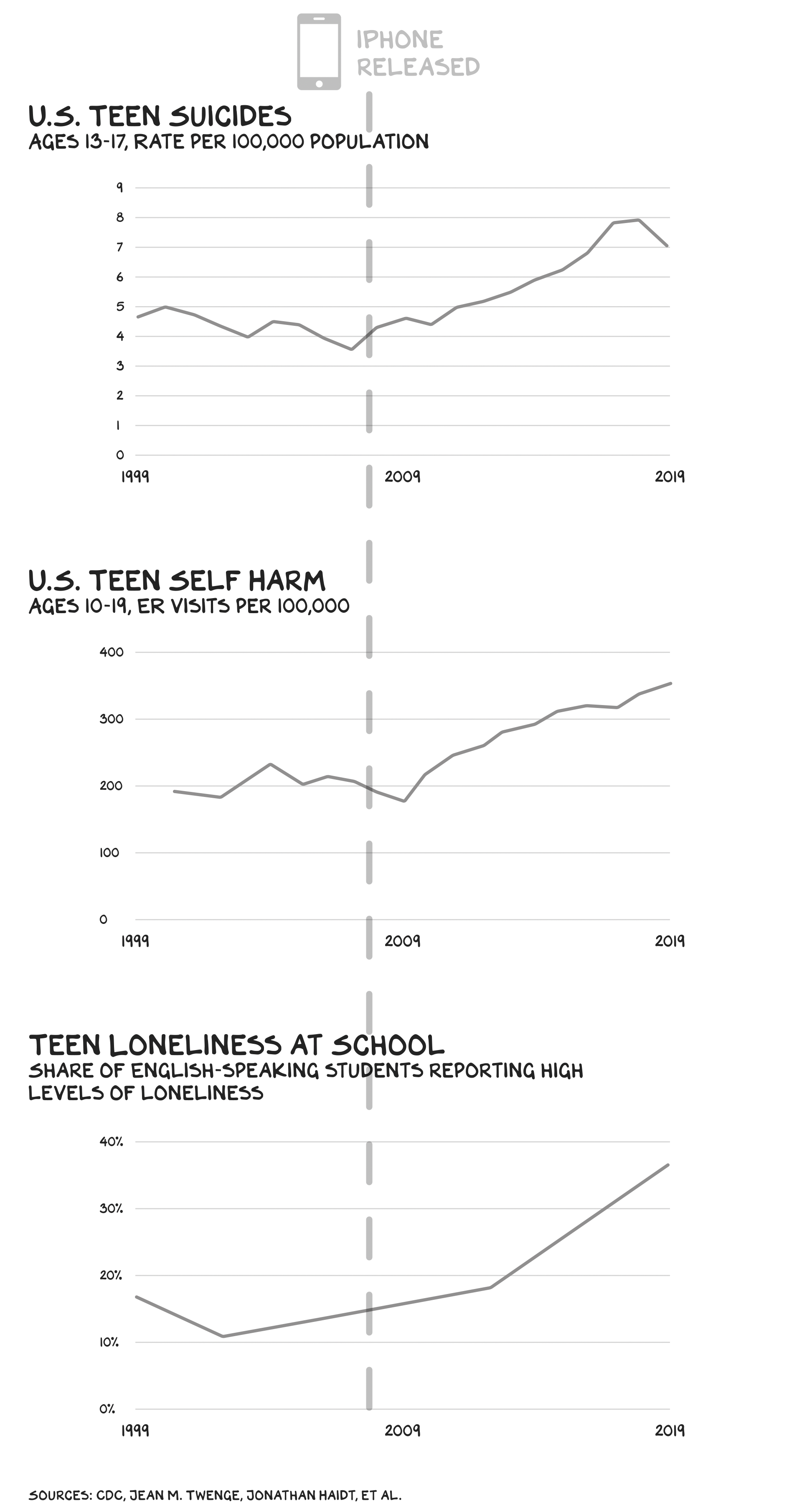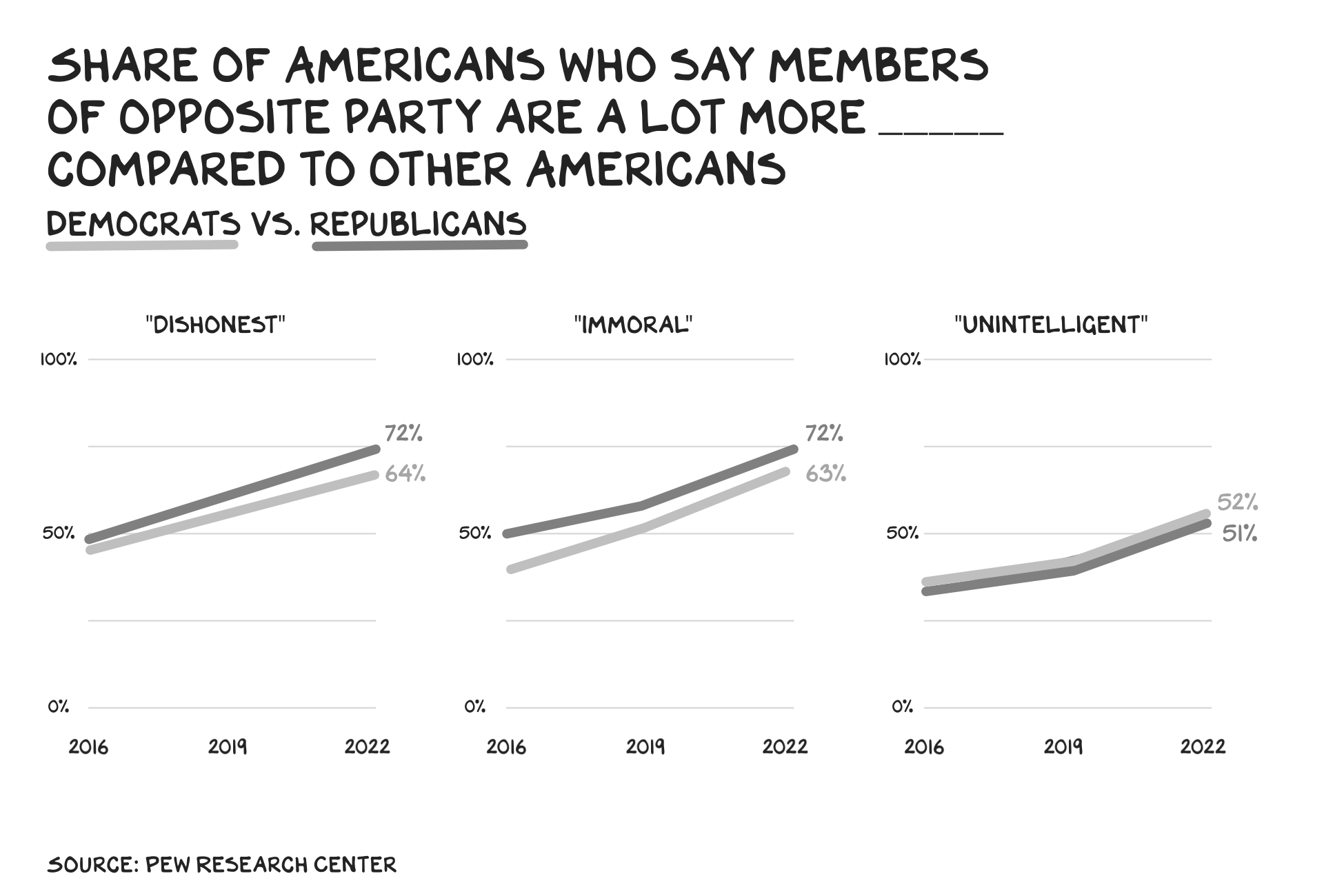Emissions
Courtesy of Scott Galloway, No Mercy/No Malice, @profgalloway
The universe is a product of the collision of materials and gases that added value to one another. Humanity’s ascent to the world’s apex predator is also a function of our ability to add value, converting one substance into another. We learned to morph wood into fire, and walnut oil into ink and then into information. We turn sand into windows, computer chips, and water filters. Conversion often produces byproducts, sometimes a bonus: Converting fat into soap produces glycerin, useful in everything from moisturizers to explosives.
More often, those byproducts are a problem. Roasting coffee beans emits compounds linked to lung disease. The vapors that escape aging whiskey feed a black fungus that’s eating whole towns in Kentucky. One hugely inefficient conversion is plants into meat. It takes 25 pounds of feed to produce a pound of beef; 40 times more energy goes into beef than comes out of it as food. Livestock account for 14% of all carbon emissions — equal to all modes of transportation combined.
Carbon emissions are believed to be the mother of all negative byproducts. The conversion of fossil fuels (themselves the product of a conversion) into energy has been the boon and burden of the past century. But there’s something worse:
Converting attention into profit.
It’s made a very few very wealthy and left the rest of us choking on the fumes: rage and polarization. The discharge of the attention economy weakens our immune system, rendering us vulnerable to other emissions, as polarization paralyzes our ability to respond to other externalities: inequality, autocracy, gun deaths, depression, addiction, obesity, and the OG itself, carbon.
The Attention Economy
The media business was built on the back of the attention-to-profits arbitrage, but for centuries the conversion technology was rudimentary, and its emissions were tolerable. Mass media had issues, but free media made us more informed, entertained, and connected. When we released ad-supported reticulated pythons into the online ecosystem, however, they became an invasive species. Converting attention into profit has become the world’s best business. Between 2002 and 2022, Google generated over $1 trillion in ad revenue. Amazon, a retailer, makes $38 billion a year selling ads. Thanks to rising oil prices, 2022 was a historically profitable year for Chevron, up 127% from 2021; Google, which had a terrible year, registered double Chevron’s profits. In 1980, 7 of the 10 most valuable businesses in America were oil companies. Today, 7 of the top 10 profit from refined attention. An eighth, Tesla, built the world’s most valuable automaker by mastering the attention-harvesting channels of social media.
Converting attention into profit has become the world’s best business. Between 2002 and 2022, Google generated over $1 trillion in ad revenue. Amazon, a retailer, makes $38 billion a year selling ads. Thanks to rising oil prices, 2022 was a historically profitable year for Chevron, up 127% from 2021; Google, which had a terrible year, registered double Chevron’s profits. In 1980, 7 of the 10 most valuable businesses in America were oil companies. Today, 7 of the top 10 profit from refined attention. An eighth, Tesla, built the world’s most valuable automaker by mastering the attention-harvesting channels of social media.
The emissions have matched the profits. Pre-digital media cast the broadest net possible. The internet is spearfishing at scale. Your New York Times home page is different from mine. Our TikTok For You pages are likely from different planets.
Alignment Problem
Facebook, Twitter, YouTube, and anything else with a “feed” employ teraflops of processing power to register signals and calibrate their messages to keep us scrolling. Even if that content makes us angrier or drives us into more and more narrow tribal identities. Old media is populated with beautiful people, usually in sleeveless dresses, as sex sells. It turns out, rage and tribalism sell better.
This is not the first time I’ve raised this alarm, nor am I the only one raising it. Hungry for novelty, though, the chattering classes have moved on, and artificial intelligence is now at peak hype cycle. AI skeptics (and many supporters) fear that powerful AI will pursue goals divergent from our own. This is known as the “alignment problem.” The classic example is Nick Bostrum’s Paper Clip Maximizer. Tell an advanced AI to produce as many paper clips as possible, and it may stop at nothing to fulfill its mission, including killing off humans and turning our entire solar system into a giant paper clip machine. Only here’s the thing: Powerful AI is already here, and it’s already doing this. It’s called Instagram. Advertising is optimizing media — and by extension, optimizing us — not for paper clips, but for fear and polarization.
The model works so well that it’s no longer limited to customized feeds. Traditional media is getting in on the action. Rupert Murdoch primes the rage machine at Fox News, The Wall Street Journal’s editorial page, and the New York Post. If there was any doubt that it’s all an exercise in conversion, ignoring emissions, Murdoch dispelled them under oath when he testified that Fox was pushing bullshit stories about Dominion voting machines, even though he and his biggest hosts knew the theories were “insane” and “shockingly reckless.” “It is not red or blue, it is green,” he admitted. Wall-to-wall coverage of transgender youth athletes and “immigrant caravans” are to Fox News what the Safaniya Oil Field is to Saudi Aramco.
It’s not just companies — individuals are also climate terrorists. How did a failed businessman take over the GOP and ascend to the White House? Simple: ratings via rage. And not just on Fox; CNN couldn’t tear itself away, and neither could we. The richest person in the world is so addicted to the rage machine that he paid $44 billion to make it his own. Misogynist Andrew Tate made millions gaming the social algorithm by feeding it vile content. His team determined the optimal ratio of positive to negative comments on videos is 60/40 — he wanted nearly half his viewers to be angry. Machiavelli asked if it was better to be loved or feared. Turns out, neither. You want to piss people off. In the new economy, attention is oil, and whoever refines it most efficiently into rage and polarization.
A fair question: “Scott, aren’t you in the business of ad-supported media and active on ad-supported platforms?” We are, but we don’t shape content to inflame, enrage and pose for algorithms. Also, to the best of our ability, we fact-check our content.
Gasping for Air
There are first- and second-order effects from these emissions. The first-order effects are bad. The second-order effects are worse.
The first-order effects: Between 2009 and 2019, teen depression rates doubled. Last year, 1 in 3 teen girls seriously considered suicide and 1 in 5 LGBTQ teens attempted suicide. Over the past decade in the U.K., self-harm among young girls and boys has increased 78% and 134%, respectively. Teens now spend an average of 8.2 hours per day on their devices — many log double that time: 35% of American teens report using one of YouTube, TikTok, Instagram, Snapchat, or Facebook “almost constantly.”
How to prove causation and not correlation? A: Use common sense and eliminate every other cause. The academic term to describe social media’s impact on society is … awful. Its corrosive harms are myriad, from undermining dating and relationship formation to degrading our ability to process information. Even with this rapid corrosion, is the attention crisis really worse than climate change? I think it is. Because the impact of those emissions on our discourse isn’t just to make it coarse, but to make it nonfunctional. It’s not HIV that kills, but the opportunistic infections the patient is helpless to fight. On Twitter, lies spread six times faster than truth. The Twitter engineer who created the retweet button regrets it — as he put it: “We might have just handed a 4-year-old a loaded weapon.”
Even with this rapid corrosion, is the attention crisis really worse than climate change? I think it is. Because the impact of those emissions on our discourse isn’t just to make it coarse, but to make it nonfunctional. It’s not HIV that kills, but the opportunistic infections the patient is helpless to fight. On Twitter, lies spread six times faster than truth. The Twitter engineer who created the retweet button regrets it — as he put it: “We might have just handed a 4-year-old a loaded weapon.”
It reaches beyond lies. Research shows the most viral news articles are those that elicit anger. The combination of misinformation and rage online has led to a general distrust in mainstream media. Fewer than 6 in 10 Americans trust information that comes from national news organizations, an all-time low. That distrust is amplified across party lines, and we’ve now reached a point where half of Democrats and a third of Republicans aren’t comfortable with their child marrying someone of the opposite party — in 1960, those numbers were around 5% for both.
Atomized
The path to collapse is atomization, and we are fraying every day. The problems are significant: climate change, rogue states, the fraught China-U.S. relationship, pandemics. Yet it’s difficult to have a dialogue, much less develop consensus on solutions and action. The rage machine sorts us into camps that are increasingly distrustful of one another and very difficult to escape. During the pandemic, there was urgent interest in finding the source of Covid. Since illness had originated in the same Chinese city as a major research center that studied coronaviruses, a lab leak was an obvious theory. Yet once voices on the right endorsed this explanation, the left became suspicious of its veracity, and the algorithms spun up. On the left, raising the lab leak theory was labeled racist. None of us is immune to our biases — that’s the nature of bias. You can’t read the label from inside the bottle. And the excretions of the Attention Economy are steroids for bias. In addition, it’s easier to fool Americans than convince us we’ve been fooled. As a result, most of us believe we’re part of a small cohort that sees the real issue and isn’t subject to bias fueled by the rage machine.
None of us is immune to our biases — that’s the nature of bias. You can’t read the label from inside the bottle. And the excretions of the Attention Economy are steroids for bias. In addition, it’s easier to fool Americans than convince us we’ve been fooled. As a result, most of us believe we’re part of a small cohort that sees the real issue and isn’t subject to bias fueled by the rage machine.
Taking the Temperature Down
Climate scientists have proven rising temperatures are causing widespread damage, and if we don’t reduce emissions, things will get worse. That will take collective action, and collective action requires civil discourse. So, how do we debilitate the rage machine? How do we take the temperature down?
Building the consumer internet on advertising was the original sin. Serving ads next to our search bars and on our homepages gave us a free internet via layaway, but the payments have become untenable.
Separating the consumer and the customer creates an alignment problem. We need to reconnect them. Paid content is to an ad-supported model what renewables are to internal combustion. Subscriptions connect end users to content providers directly, in that they are customers, vs. products being harvested for the ad model’s true customer, the advertiser. It’s a basic observation, but still holds that Fox and Meta have levied a great deal more damage than Netflix or LinkedIn (most of its revenue comes from recruitment services), neither of which is depressing our teens or being weaponized by the GRU.
Subscriptions are not the only payment model — micropayments are the most rational way to connect value with price. However, micropayments continue to be the missing piece, the fission of media: promise vs. practical performance. One of the downsides of moving away from free media is that we’ll further bifurcate into a world of Android (ad supported) vs. iOS (premium). I’ve always felt the assumption that “people can’t afford” subscription content was a bit hyperbolic, as almost two-thirds of U.S. households are Netflix consumers. With robust micropayments technology, businesses could differentiate and price discriminate (i.e. base charges, in part, on ability to pay).
An AI generated, textual news summary might cost a digital penny, while the same content with a layer of design, charts, and an audio option goes for 25¢. There is scant transportation that is free, but trains, planes, automobiles, buses, and bikes put faster-than-walking travel within reach for nearly all Americans.
Hooligans
I’ve been in the U.K. for eight months now. The weather sucks (really awful), and there isn’t as much opportunity here. However, there appear to be greater emissions standards. People, generally speaking, are more civil to one another. I’ve been to a football match almost every week, and the only hooligans I’ve seen are U.S. media notifications on my phone.
In the U.S., our last president and the wealthiest man openly mock the disabled, and we tolerate it. We let domestic and foreign platforms run unchecked, even as their algorithms elevate imprisoned misogynists into global celebrities and email images of nooses and razor blades to preteen girls contemplating self-harm. Our new heroes hawk EVs and metaverses while generating more emissions than a coal-fired plant. America is still the biggest, most prosperous house on the global block. But it’s dysfunctional and depressed, and anybody who walks by hears the inhabitants screaming at each other. Parents and leaders need to turn down the temperature, align incentives, and avoid EVs, platforms, and public figures that run on coal.
Life is so rich,
![]()
P.S. Join us for Office Hours on Wednesdays on the Prof G Pod, where Scott answers your questions.
P.S. Can you build a billion-dollar product that doesn’t destroy our mental health and/or the planet? It’s worth a shot. Our new Product Strategy Sprint closes enrollment next Wednesday. Sign up now.
Image by Alan Frijns from Pixabay



